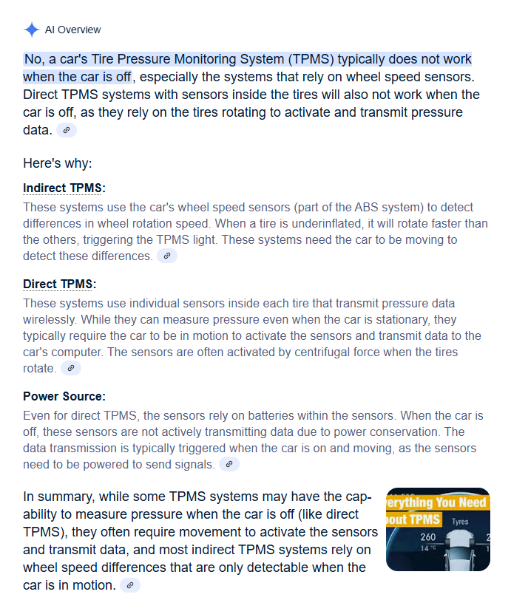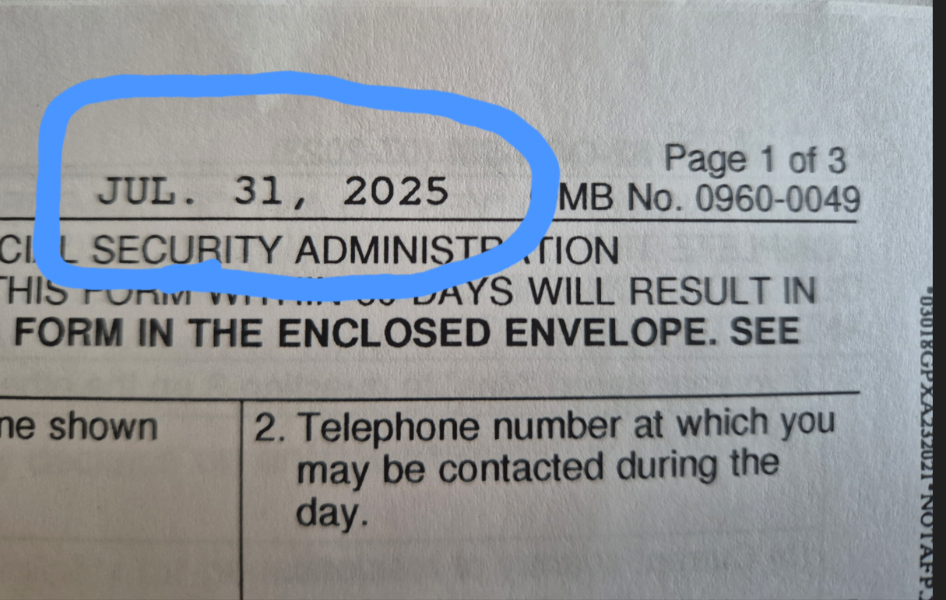-
Posts
29,208 -
Joined
-
Last visited
Pib's Achievements
-
Yea, until you pointed out the tire pressure doesn't update on the app when the EV is turned off I thought it was real time pressure---didn't matter if the car was off or on. But I really didn't check tire pressure that often using the app. Actually my two main uses of the app is to monitor home wall charger charging rate/charge percentage and turn the A/C on to cool down the cabin before hopping into the car like when leaving Lotus, Big C, etc., especially if the car was parked in the sun.
-
OK, now I understand. Today after reading above I did some testing as I was out and about in Bangkok doing several stops here and there where I would turn off the Atto while parked for a while.. When using the app to check tire pressure you are right it will just display the last reading just before you turned the car off. No updated reading until you start the car again. In doing some googling on Tire Pressure Measurement Systems (TPMS) there appears to be two types...."direct and indirect" measurement. In a direct where the tire valve includes a battery-powered or RFID-powered measurement system which typically only works when the car is turned on because that's the only time the "central TPMS electronic module" is talking to/communicating with the four tires. And the indirect method compares wheel rotation to determine pressure....no in tire measurement system. Anyway, Google AI pretty much said the great majority of direct TPMS's (which is what BYD uses) usually only work when the car is powered on which is the only time the central TPMS electronic module in the car is communicating to the measurement modules in the tire. When the car is turned off that central module is also turned off. And indirect TPMS the car has to be turn on "and moving in order to measure wheel rotation. When looking at the Atto User's Manual it does not say the TPMS does not work when the car is turned off but implies such like saying "when the system is running..." or "when the ignition switch is on...." in various places which implies to me the TPMS only works when the car is turned on. You can also get a tire "temperature" warning if the tire is too hot. Additionally, I got a tire "temp" warning "once" whlle driving along at highway speeds and also the TMPS said the pressure was 75 psi. I stopped the car, looked at the offending tire---it looked and felt normal....all four tires looked OK and temp felt normal. I turned the car off and immediately restarted and the warnings went away with the offending tire now showing normal psi. I guess that was just a glitch/a communications error between the tire module and central TPMS module. And during my testing today I found out the "Cabin Temperature" app reading "will update" when the car is turned off. I guess that measurement module continues to work/respond to app requests when the car is turned off. Probably needs very, very little power to work in comparison to the TPMS module which needs to transmit a signal to the tires. But when the car is turned off you do need to press the temp reading icon which takes you to another page and then you immediately go back a page and then the cabin temp will display. You may need to do this 2, 3, or 4 times to force a cabin temp reading when the car is turn off....and that reading definitely changes the longer the car is turned off as the cabin heats up since the A/C is no longer running. But my testing confirmed a person can't force the TMPS to take a reading when the car is off as apparently its central TPMS module is powered-down to save power. And from a safety stand point if you have an under-inflated tire the car is going to indicate/warn you when the car is first turned on, while it running down the road, and also when you turn the car off a warning is suppose to appear for a few seconds just before the car completely powers down according to the manual. So, even if the tire drops to a certain under-inflated level when turned off, parked overnight, etc., as soon as you turn the car on you will get a warning if the tire is below 75% of the standard pressure.
-
2025 SSA Form 7162 - "Hello, are you dead yet?" forms.
Pib replied to connda's topic in US & Canada Topics and Events
BINGO!!!! Received my 7162 today/5 Aug 2025 here in Bangkok. Date in upper right hand corner of the 7162 was 31 Jul 2025 (see image below). No postage marking on envelope to indicate when it was really mailed. Instructions to return as previous years...saying return within 60 days. -
I expect you are using an Apple phone. Android Google Play store still shows 1 July 2025 Ver 2.8.1 as the latest....I expect BYD will update the Android version soon. Regarding how often the app is updated, the time of the latest updated data is shown on the app main page. That data is only refreshed when you close and reopen the app OR if you force a refresh on the main screen. Additionally, since the app is just reading a subset of OBD2 data, all OBD2 data is "not" being refreshed/updated by the car like every second. Different OBD2 data elements are refreshed at different rates depending on their importance...what the car manufacturer determines. It may just do a refresh every 30 seconds or so (or maybe longer) depending on the particular OBD2 data and also depending on whether the car is on or off. Like if a person is charging, the car is off, and they see their wall charger real time power meter say drop from 30 amps to 16amps...or say 6KW to 3KW the EV OBD2 data may not reflect that change for around 30 seconds when the car is turned off. Now if that every 30 seconds refresh is saying occurring at the 30 second mark on the clock but you request an update/refresh at 25 seconds on the clock then you'll probably not see an updated valve until 35 seconds later as your refresh request occurred just before the car's programmed OBD2 refresh time. And there is separate OBD2 data feeding the EV's display which is fast responding compared to other slower responding OBD2 data reporting depending on whether the car is on or off. And the tire pressure OBD2 data refresh/monitoring may not be occurring every few seconds but maybe every 30 seconds (or more)....and as mentioned it makes a difference regarding OBD2 data refresh depending on whether the EV is running or turned off. Yeap, the OBD2 data the app depends on only collecting selected OBD2 data from the EV and the EV is only doing a OBD2 refresh at selected/varying intervals.......intervals that vary depending on whether the car is on or off.......and/or a forced OBD2 data refresh is requested like when having an OBD2 dongle and associated OBD2 app asking for data.
-
Others have done it this way. However, unless something has changed in the online application it says if you don't submit the health insurance info when first applying you should upload a "Document Request Acknowledge Form for LTR Application." This form is available on the BOI LTR website...completing the form you are basically saying you are aware you must provide a health insurance policy when BOI asks for it. I guess by completing this form you are confirming you are aware of the requirement, will provide it later when BOI asks for it, and not just wasting BOI's time. https://ltr.boi.go.th/documents/Document-Request-Acknowledgement-Form-for-LTR-Application.pdf A snapshot from the application upload area when I did my LTR application in late 2022. Notice where it talks above form. Does it still say the same in "your online application area."
-
2025 SSA Form 7162 - "Hello, are you dead yet?" forms.
Pib replied to connda's topic in US & Canada Topics and Events
The two of us in our household both just received our forms this morning in the postal mail, August 4, 2025. The forms are dated July 31, 2025. Letsliveinfrance.com Wow...4 days from US to France. About the fastest I ever got any regular 1st class mail from US to Bangkok was around 7 to 9 days. -
2025 SSA Form 7162 - "Hello, are you dead yet?" forms.
Pib replied to connda's topic in US & Canada Topics and Events
Unsure what you mean? Maybe you mean a bar- coded 7162 from last year? -
2025 SSA Form 7162 - "Hello, are you dead yet?" forms.
Pib replied to connda's topic in US & Canada Topics and Events
They have a Remarks area just for such things...whether they now have the manpower/time for a human to process/read the forms I couldn't say. Nowadays there are very, very intelligent scanning machines that make humans less needed everyday. -
2025 SSA Form 7162 - "Hello, are you dead yet?" forms.
Pib replied to connda's topic in US & Canada Topics and Events
That could very well be the case. -
2025 SSA Form 7162 - "Hello, are you dead yet?" forms.
Pib replied to connda's topic in US & Canada Topics and Events
Well, they would just know it's not a bar-coded form. But a manually submitted form would have a mid 2025 date and possibly include remarks from the sender that a manual form is being submitted because the annual bar- coded form is probably lost in the mail/delayed. I included such a memo and remarks on the manual form I mailed in a few days ago. And if/when a bar-coded form arrives I'll complete and send back. -
2025 SSA Form 7162 - "Hello, are you dead yet?" forms.
Pib replied to connda's topic in US & Canada Topics and Events
It just the way your earlier post was written that it implied (at least to me) you may have seen some very recent announcement from SSA, maybe called them, etc., and they said manual 7162s were now obsolete, no longer accepted, waste of time to mail to Wilkes Barre, etc. -
2025 SSA Form 7162 - "Hello, are you dead yet?" forms.
Pib replied to connda's topic in US & Canada Topics and Events
Your reference? -
2025 SSA Form 7162 - "Hello, are you dead yet?" forms.
Pib replied to connda's topic in US & Canada Topics and Events
Like I mentioned earlier I plan to mail a manual 7162 to Wilkes Barre the first week of August. I mailed it a few days ago. That's all I can do. It may or may not be processed as none of us know what SSA leadership has directed customer service and/or FBUs to tell customers. Will now just wait and see if the "delayed bar-coded 7162 mailing" ever occurs as it hard to believe many things coming out of the current regime as govt employees from the top dog to the employees in the trenches (like customer service) are afraid of saying anything that states/implies things are in turmoil at their organization.

















